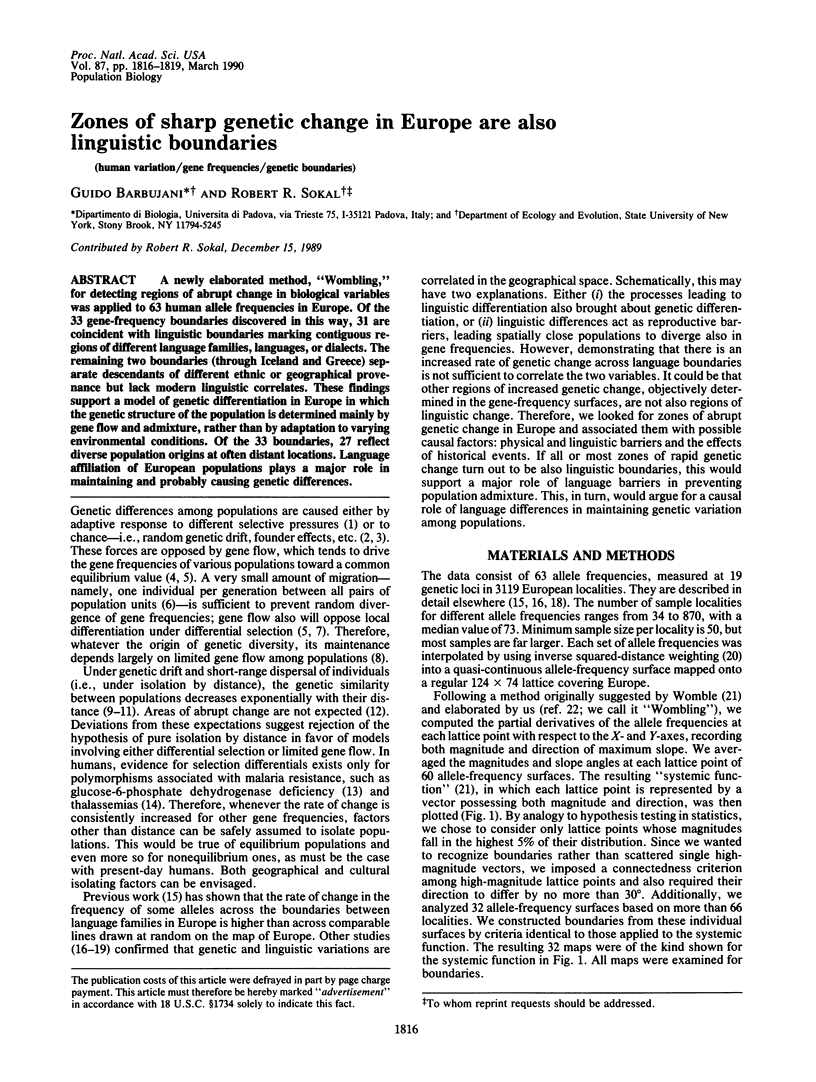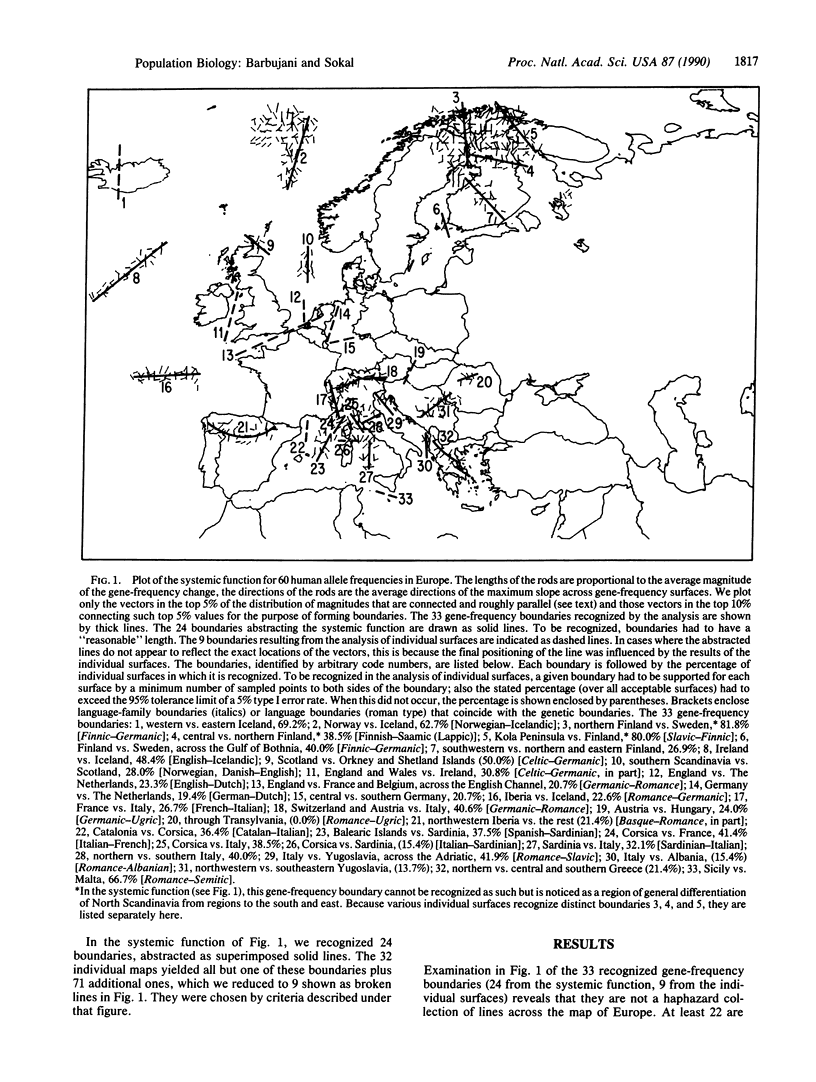Abstract
A newly elaborated method, "Wombling," for detecting regions of abrupt change in biological variables was applied to 63 human allele frequencies in Europe. Of the 33 gene-frequency boundaries discovered in this way, 31 are coincident with linguistic boundaries marking contiguous regions of different language families, languages, or dialects. The remaining two boundaries (through Iceland and Greece) separate descendants of different ethnic or geographical provenance but lack modern linguistic correlates. These findings support a model of genetic differentiation in Europe in which the genetic structure of the population is determined mainly by gene flow and admixture, rather than by adaptation to varying environmental conditions. Of the 33 boundaries, 27 reflect diverse population origins at often distant locations. Language affiliation of European populations plays a major role in maintaining and probably causing genetic differences.
Full text
PDF



Selected References
These references are in PubMed. This may not be the complete list of references from this article.
- Barbujani G. Autocorrelation of gene frequencies under isolation by distance. Genetics. 1987 Dec;117(4):777–782. doi: 10.1093/genetics/117.4.777. [DOI] [PMC free article] [PubMed] [Google Scholar]
- Barbujani G. Diversity of some gene frequencies in European and Asian populations. IV. Genetic population structure assessed by the variogram. Ann Hum Genet. 1988 Jul;52(Pt 3):215–225. doi: 10.1111/j.1469-1809.1988.tb01099.x. [DOI] [PubMed] [Google Scholar]
- Cavalli-Sforza L. L., Piazza A., Menozzi P., Mountain J. Reconstruction of human evolution: bringing together genetic, archaeological, and linguistic data. Proc Natl Acad Sci U S A. 1988 Aug;85(16):6002–6006. doi: 10.1073/pnas.85.16.6002. [DOI] [PMC free article] [PubMed] [Google Scholar]
- Cavalli-Sforza L. L. Population structure and human evolution. Proc R Soc Lond B Biol Sci. 1966 Mar 22;164(995):362–379. doi: 10.1098/rspb.1966.0038. [DOI] [PubMed] [Google Scholar]
- Harding R. M., Sokal R. R. Classification of the European language families by genetic distance. Proc Natl Acad Sci U S A. 1988 Dec;85(23):9370–9372. doi: 10.1073/pnas.85.23.9370. [DOI] [PMC free article] [PubMed] [Google Scholar]
- Hedrick P. W., Thomson G. Evidence for balancing selection at HLA. Genetics. 1983 Jul;104(3):449–456. doi: 10.1093/genetics/104.3.449. [DOI] [PMC free article] [PubMed] [Google Scholar]
- Kimura M, Weiss G H. The Stepping Stone Model of Population Structure and the Decrease of Genetic Correlation with Distance. Genetics. 1964 Apr;49(4):561–576. doi: 10.1093/genetics/49.4.561. [DOI] [PMC free article] [PubMed] [Google Scholar]
- Livincstone F. B. Malaria and human polymorphisms. Annu Rev Genet. 1971;5:33–64. doi: 10.1146/annurev.ge.05.120171.000341. [DOI] [PubMed] [Google Scholar]
- Menozzi P., Piazza A., Cavalli-Sforza L. Synthetic maps of human gene frequencies in Europeans. Science. 1978 Sep 1;201(4358):786–792. doi: 10.1126/science.356262. [DOI] [PubMed] [Google Scholar]
- Morton N. E., Yee S., Harris D. E., Lew R. Bioassay of kinship. Theor Popul Biol. 1971 Dec;2(4):507–524. doi: 10.1016/0040-5809(71)90038-4. [DOI] [PubMed] [Google Scholar]
- Piazza A., Cappello N., Olivetti E., Rendine S. A genetic history of Italy. Ann Hum Genet. 1988 Jul;52(Pt 3):203–213. doi: 10.1111/j.1469-1809.1988.tb01098.x. [DOI] [PubMed] [Google Scholar]
- Silvestroni E., Bianco I. Screening for microcytemia in Italy: analysis of data collected in the past 30 years. Am J Hum Genet. 1975 Mar;27(2):198–212. [PMC free article] [PubMed] [Google Scholar]
- Slatkin M. Gene flow and the geographic structure of natural populations. Science. 1987 May 15;236(4803):787–792. doi: 10.1126/science.3576198. [DOI] [PubMed] [Google Scholar]
- Slatkin M., Maruyama T. Genetic drift in a cline. Genetics. 1975 Sep;81(1):209–222. doi: 10.1093/genetics/81.1.209. [DOI] [PMC free article] [PubMed] [Google Scholar]
- Slatkin M. Population structure and evolutionary progress. Genome. 1989;31(1):196–202. doi: 10.1139/g89-034. [DOI] [PubMed] [Google Scholar]
- Sokal R. R. Genetic, geographic, and linguistic distances in Europe. Proc Natl Acad Sci U S A. 1988 Mar;85(5):1722–1726. doi: 10.1073/pnas.85.5.1722. [DOI] [PMC free article] [PubMed] [Google Scholar]
- Sokal R. R., Harding R. M., Oden N. L. Spatial patterns of human gene frequencies in Europe. Am J Phys Anthropol. 1989 Nov;80(3):267–294. doi: 10.1002/ajpa.1330800302. [DOI] [PubMed] [Google Scholar]
- Sokal R. R., Jacquez G. M., Wooten M. C. Spatial autocorrelation analysis of migration and selection. Genetics. 1989 Apr;121(4):845–855. doi: 10.1093/genetics/121.4.845. [DOI] [PMC free article] [PubMed] [Google Scholar]
- Sokal R. R., Oden N. L., Legendre P., Fortin M. J., Kim J. Y., Vaudor A. Genetic differences among language families in Europe. Am J Phys Anthropol. 1989 Aug;79(4):489–502. doi: 10.1002/ajpa.1330790406. [DOI] [PubMed] [Google Scholar]
- Sokal R. R., Oden N. L., Thomson B. A. Genetic changes across language boundaries in Europe. Am J Phys Anthropol. 1988 Jul;76(3):337–361. doi: 10.1002/ajpa.1330760308. [DOI] [PubMed] [Google Scholar]
- Sokal R. R., Wartenberg D. E. A Test of Spatial Autocorrelation Analysis Using an Isolation-by-Distance Model. Genetics. 1983 Sep;105(1):219–237. doi: 10.1093/genetics/105.1.219. [DOI] [PMC free article] [PubMed] [Google Scholar]
- WOMBLE W. H. Differential systematics. Science. 1951 Sep 28;114(2961):315–322. doi: 10.1126/science.114.2961.315. [DOI] [PubMed] [Google Scholar]
- Wright S. Evolution in Mendelian Populations. Genetics. 1931 Mar;16(2):97–159. doi: 10.1093/genetics/16.2.97. [DOI] [PMC free article] [PubMed] [Google Scholar]


